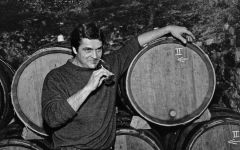Guy Breton Morgon Vieilles Vignes 2019



Product Details
Your Rating
Somm Note
Winemaker Notes
There’s great fruit here, raspberries and pomegranates, a traditional, rustic, spicy nose, stony freshness from the schist soil, and a refreshing acidity. Eighty-year-old vines give this Guy some muscle, too.
Other Vintages
2018-
Robert
Parker -
Wine
Spectator -
James
Suckling
-
Wine
Spectator



Guy Breton is known by his friends as Petit Max – though he is anything but petit, by the way. He took over the family domaine from his grandfather in 1986. Until that point, the family was selling their fruit to the large cooperative wineries which dominated the region and were gravitating towards a uniform style. The rise of imported yeast cultures to impart flavor and aroma, the use of high-tech carbonic maceration, and the widespread commercialization of Beaujolais Nouveau debased the region’s reputation, and Beaujolais came to be seen as one-dimensional, lacking any expression of the native terroir. Following the example of traditionalist Jules Chauvet, Guy and three other local vignerons, Marcel Lapierre, Jean-Paul Thévenet, and Jean Foillard, soon hoisted the flag of this back-to-nature movement. Kermit dubbed this clan the Gang of Four, and the name has stuck ever since. The Gang called for a return to the old practices of viticulture and vinification: starting with old vines, never using synthetic herbicides or pesticides, harvesting late, rigorously sorting to remove all but the healthiest grapes, adding minimal doses of sulfur dioxide or none at all, and refusing both chaptalization and filtration. The end result allows Morgon to express itself naturally, without make-up or plastic surgery: rustic, spicy, loaded with schist minerals and at the same time, refreshing and deep-down delicious.
Breton’s domaine is comprised of three hectares (only 7.2 acres), eighty percent of which lies in the appellation of Morgon, around the village of Villié-Morgon. The vines range in age from 8 to 80 years, with the 80-year-old vines dedicated to the “Vieilles Vignes” cuvée. Guy’s property is located in the microclimates “Saint-Joseph” and “Grand Cras,” where the naturally low pH of the soil creates favorable conditions for Breton’s sulfur-free vinification.

Delightfully playful, but also capable of impressive gravitas, Gamay is responsible for juicy, berry-packed wines. From Beaujolais, Gamay generally has three classes: Beaujolais Nouveau, a decidedly young, fruit-driven wine, Beaujolais Villages and Cru Beaujolais. The Villages and Crus are highly ranked grape growing communes whose wines are capable of improving with age whereas Nouveau, released two months after harvest, is intended for immediate consumption. Somm Secret—The ten different Crus have their own distinct personalities—Fleurie is delicate and floral, Côte de Brouilly is concentrated and elegant and Morgon is structured and age-worthy.

The bucolic region often identified as the southern part of Burgundy, Beaujolais actually doesn’t have a whole lot in common with the rest of the region in terms of climate, soil types and grape varieties. Beaujolais achieves its own identity with variations on style of one grape, Gamay.
Gamay was actually grown throughout all of Burgundy until 1395 when the Duke of Burgundy banished it south, making room for Pinot Noir to inhabit all of the “superior” hillsides of Burgundy proper. This was good news for Gamay as it produces a much better wine in the granitic soils of Beaujolais, compared with the limestone escarpments of the Côte d’Or.
Four styles of Beaujolais wines exist. The simplest, and one that has regrettably given the region a subpar reputation, is Beaujolais Nouveau. This is the Beaujolais wine that is made using carbonic maceration (a quick fermentation that results in sweet aromas) and is released on the third Thursday of November in the same year as harvest. It's meant to drink young and is flirty, fruity and fun. The rest of Beaujolais is where the serious wines are found. Aside from the wines simply labelled, Beaujolais, there are the Beaujolais-Villages wines, which must come from the hilly northern part of the region, and offer reasonable values with some gems among them. The superior sections are the cru vineyards coming from ten distinct communes: St-Amour, Juliénas, Chénas, Moulin-à-Vent, Fleurie, Chiroubles, Morgon, Regnié, Brouilly, and Côte de Brouilly. Any cru Beajolais will have its commune name prominent on the label.
